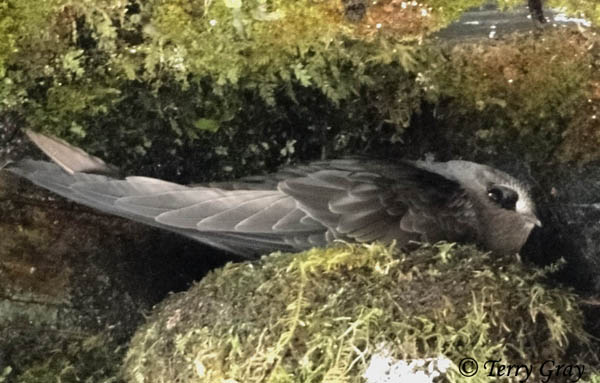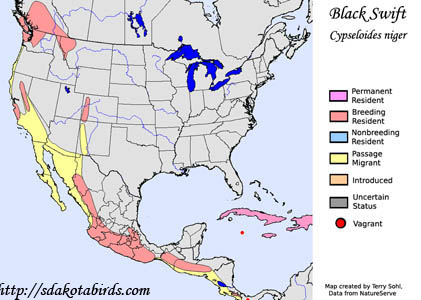| Length: 7.25 inches | Wingspan: 18 inches | Seasonality: Non-resident in South Dakota |
| ID Keys: Largest North American swift, dark overall with broad wings and tail compared to other swifts | ||
 The
Black Swift is the largest swift species in North America. They are a
somewhat enigmatic species, given their rather unique habitat preferences.
While Black Swifts can forage in nearly any habitat that has flying insects
available for prey, their breeding preferences in North America are quite
distinct. Nesting occurs in protected crevices in rock faces and
cliffs, and protected areas such as wet, rocky cliff faces behind waterfalls
are a preferred nesting site. Given the scarcity of such habitat, the
breeding range of the species is scattered and local.
The
Black Swift is the largest swift species in North America. They are a
somewhat enigmatic species, given their rather unique habitat preferences.
While Black Swifts can forage in nearly any habitat that has flying insects
available for prey, their breeding preferences in North America are quite
distinct. Nesting occurs in protected crevices in rock faces and
cliffs, and protected areas such as wet, rocky cliff faces behind waterfalls
are a preferred nesting site. Given the scarcity of such habitat, the
breeding range of the species is scattered and local.
Habitat: During the breeding season, Black Swifts are found using rocky ledges or rocky crevices for nesting. Locations are often along the coastline, or in protected areas behind waterfalls.
Diet: Feeds on flying insects.
Behavior: Only feeds while in flight, using it's large mouth opening to grab insects from mid-air.
Nesting: The nest of a Black Swift is a small relatively flat cup of mud, mosses, and ferns, placed on a protected rocky ledge or crevice. The female lays a single egg, with both parents helping to incubate it. Upon hatching, both parents help to feed the young, with the young leaving the nest after about 45 days.
Interactive eBird Map: Click to access an interactive eBird map of Black Swift sightings
Song: Series of chattering chip notes, typically slowing in pace towards the end.
Migration: Considered a permanent resident in parts of their range, such as in parts of the Caribbean, Mexico, and Central America. However, birds in the United States and Canada are migratory.
Similar Species: In range, most likely to be confused with the White-throated Swift.
Conservation Status: Populations have declined in some locations, but they are still spread across a wide geographic region and are present in adequate numbers in much of their natural range. The IUCN lists the Black Swift as a species of "Least Concern".
Further Information: 1) USDA Forest Service - Black Swift - A Technical Conservation Assessment
2) The Coolest Bird - A History of the Black Swift
3) BirdWeb.org - Black Swift
Photo Information: Photo taken by Terry Gray - July 24th, 2011 - Shoshone County, Idaho - Photo licensed under Creative Commons Attribution ShareAlike 2.0 Generic License
| Click below for a higher-resolution map |
 |
| South Dakota Status: Non-resident in South Dakota |
Additional Black Swift Photos (coming soon!!)
